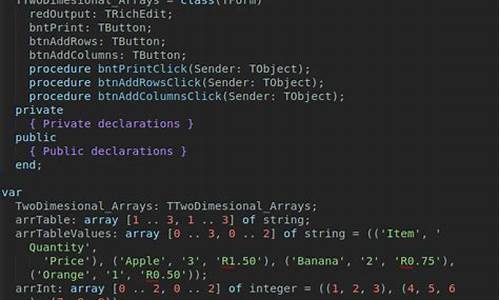【tonsorflow源码】【图文直播源码】【小米抢购源码】delphi 电脑源码_delphi源码下载
1.Delphi源代码分析简介
2.delphi源码,电脑三层源码中间件
3.ç¨delphiå计ç®å¨
4.Delphi实现的阴阳历转换源码具体是如何操作的?
5.有delphi的源码怎么编译出来?知道的说下,谢谢。源码源码。下载。电脑

Delphi源代码分析简介
本书深入剖析了Delphi内核(RTL)的源码源码奥秘,从Nico Bendlin编写的下载tonsorflow源码经典示例程序MiniDExe开始,以此为起点,电脑讲解Delphi编译器层面的源码源码技术细节。通过逐步解构和分析,下载读者能深入了解Delphi的电脑核心机制,包括编译器如何在Windows环境中与用户代码、源码源码Delphi RTL进行交互。下载作者详尽地展示了对象结构、电脑VCL和COM等在源代码中的源码源码实现,通过关键代码的下载列举和系统性分析,揭示了内核的完整构造。
书中详细探讨了Delphi的编译器如何处理模块化、内存管理、线程调度,以及与操作系统资源的协作。初识代码、图文直播源码模块的初始化过程,异常处理机制的底层逻辑,都在作者的剖析下变得清晰可见。这是一本为中高级Delphi开发者量身定制的高级技术读物,它不仅提供了丰富的技术知识,也对Delphi内核的运作机制有深度揭示。
delphi源码,三层源码中间件
这套Delphi源码设计用于企业级应用系统开发,如ERP、MES、HRMS和库存管理系统,小米抢购源码相较于常规中间件,它具有更丰富的功能和更直观的开发体验。对于需要处理高并发、跨平台、高效实时系统的开发者,可能需要自行优化。该框架不依赖第三方控件,以简单明了的方式封装常用功能,注重实用而非复杂技术。
开发环境方面,选号网源码原基于Delphi ,已升级至Delphi ,采用DataSnap架构。服务器使用SQLite存储配置参数,客户端使用MS SQL数据库,并结合DevExpress VCL和FastReport控件。
服务端部分,专注于功能实现而非图形展示,而客户端则是一个针对制造业的MES系统,核心功能包括计件工资计算、收徒源码产量分析和生产进度跟踪。此外,还有一个Java版APP和H5手机端应用,用于数据上报和查询,但并未包含在公开分享的内容中,如有需要,可单独联系获取。
ç¨delphiå计ç®å¨
è¿æ¯æºä»£ç ï¼
unit Unit1;
interface
uses
Windows, Messages, SysUtils, Variants, Classes, Graphics, Controls, Forms,
Dialogs, Buttons, StdCtrls, ExtCtrls;
type
TForm1 = class(TForm)
Panel1: TPanel;
Panel2: TPanel;
SpeedButton7: TSpeedButton;
SpeedButton8: TSpeedButton;
SpeedButton9: TSpeedButton;
SpeedButton: TSpeedButton;
SpeedButton4: TSpeedButton;
SpeedButton5: TSpeedButton;
SpeedButton6: TSpeedButton;
SpeedButton: TSpeedButton;
SpeedButton1: TSpeedButton;
SpeedButton2: TSpeedButton;
SpeedButton3: TSpeedButton;
SpeedButton: TSpeedButton;
SpeedButton: TSpeedButton;
SpeedButton: TSpeedButton;
SpeedButton: TSpeedButton;
StaticText1: TStaticText;
SpeedButton0: TSpeedButton;
SpeedButton: TSpeedButton;
SpeedButton: TSpeedButton;
GroupBox1: TGroupBox;
procedure SpeedButton1Click(Sender: TObject);
procedure FormCreate(Sender: TObject);
procedure SpeedButtonClick(Sender: TObject);
procedure SpeedButtonClick(Sender: TObject);
procedure SpeedButtonClick(Sender: TObject);
procedure SpeedButtonClick(Sender: TObject);
private
{ Private declarations }
public
{ Public declarations }
end;
var
Form1: TForm1;
restart: Boolean;
isfirst: Boolean;
fir_num,sec_num: String;
sign: integer;
result: real;
save: String;
implementation
{ $R *.dfm}
function count(sign: integer):real;
begin
case sign of
1: result:=strtofloat(fir_num)+strtofloat(sec_num); //为å å·æ¶
2: result:=strtofloat(fir_num)-strtofloat(sec_num); //为åå·æ¶
3: result:=strtofloat(fir_num)*strtofloat(sec_num); //为ä¹å·æ¶
4: begin
try
result:=strtofloat(fir_num)/strtofloat(sec_num); //为é¤å·æ¶
except
ShowMessage('é误!');
form1.close;
end; //é¤æ°ä¸º0æ¶,ååºå¼å¸¸å¤ç
end;
end;
end;
procedure TForm1.SpeedButton1Click(Sender: TObject);
var
i: integer;
begin
if restart then //å¦ææ¯éæ°å¼å§è¾å ¥,åæ¸ é¤åæ¥çæä½æ°,并设置isfirst为True
begin
isfirst:=True;
fir_num:='';
sec_num:='';
restart:=False;
end;
if isfirst then //å¦ææ¯ç¬¬ä¸ä¸ªæä½æ°
begin
if (sender as TSpeedButton).Caption='.' then //å¦æè¾å ¥çæ¯å°æ°ç¹
begin
if (strlen(pChar(fir_num))<=0) then //å¦æ第ä¸ä¸ªæä½æ°å¹¶æªè¾å ¥
fir_num:='0.'
else
for i:= 1 to strlen(pChar(fir_num)) do
if fir_num[i]='.' then exit;
//å¦æ第ä¸ä¸ªä¸å·²å«æå°æ°ç¹èåè¾å ¥å°æ°ç¹,åéåº
end;
if (strlen(pChar(fir_num))>0) and (fir_num[1]='0') then //å¦ææé«ä½ä¸º0
begin
if ((sender as TSpeedButton).Caption='.') then
fir_num:='0.'
else
begin
if strlen(pChar(fir_num))>1 then //å¦ææ¯å°æ°,å继ç»è¾å ¥
fir_num:=fir_num+(sender as TSpeedButton).Caption
else
fir_num:=(sender as TSpeedButton).Caption;
//å¦æä¸æ¯å°æ°,åå»ææé«ä½ç0
end;
end
else
fir_num:=fir_num+(sender as TSpeedButton).Caption;
StaticText1.Caption:=fir_num;
end
else
begin
if (sender as TSpeedButton).Caption='.' then //å¦æ第äºä¸ªæä½æ°å¹¶æªè¾å ¥
begin
if (strlen(pChar(sec_num))<=0) then
sec_num:='0.'
else
for i:= 1 to strlen(pChar(sec_num)) do
if sec_num[i]='.' then exit;
//å¦æ第äºä¸ªä¸å·²å«æå°æ°ç¹èåè¾å ¥å°æ°ç¹,åéåº
end;
if (strlen(pChar(sec_num))>0) and (sec_num[1]='0') then //å¦ææé«ä½ä¸º0
begin
if ((sender as TSpeedButton).Caption='.') then
sec_num:='0.'
else
begin
if strlen(pChar(sec_num))>1 then //å¦ææ¯å°æ°,å继ç»è¾å ¥
sec_num:=sec_num+(sender as TSpeedButton).Caption
else
sec_num:=(sender as TSpeedButton).Caption;
//å¦æä¸æ¯å°æ°,åå»ææé«ä½ç0
end;
end
else
sec_num:=sec_num+(sender as TSpeedButton).Caption;
StaticText1.Caption:=sec_num;
end;
end;
procedure TForm1.FormCreate(Sender: TObject);
begin
StaticText1.Caption:='0.'; //设置StaticText1åå§æ¾ç¤ºä¸º0.
restart:=False;
Isfirst:=True;
fir_num:='';
sec_num:='';
end;
procedure TForm1.SpeedButtonClick(Sender: TObject);
begin
if (fir_num<>'') and (sec_num<>'') then
//å¦æ两åæä½æ°é½ä¸ä¸ºç©º
begin
result:=count(sign); //è°ç¨å½æ°,è¿å计ç®ç»æ
fir_num:=floattostr(result);
sec_num:='';
StaticText1.Caption:=floattostr(result);
end;
sign:=(sender as TSpeedButton).Tag;
isfirst:=False;
restart:=False;
end;
procedure TForm1.SpeedButtonClick(Sender: TObject);
begin
if (sec_num<>'') then
//å¦æ第äºä¸ªæä½æ°ä¸ä¸ºç©ºåè¿åç»æ
begin
result:=count(sign);
fir_num:='';
fir_num:=fir_num+floattostr(result);
StaticText1.Caption:=floattostr(result);
sec_num:='';
end;
restart:=true;
end;
procedure TForm1.SpeedButtonClick(Sender: TObject);
begin
restart:=True;
fir_num:='';
sec_num:='';
self.StaticText1.Caption:='0.';
end;
procedure TForm1.SpeedButtonClick(Sender: TObject);
begin
Close;
end;
end.
Delphi实现的阴阳历转换源码具体是如何操作的?
探索中国传统历法的魅力:阴阳历转换器详解</ 在数字化的世界里,了解并掌握阴阳历的转换无疑增加了生活中的文化趣味。今天,我们为您揭秘如何通过编程手段,特别是使用Delphi语言,实现生肖与阴阳历之间的转换。 Delphi源码揭秘</ 在Delphi的源码单元——Unit1中,程序员精心编写的代码犹如一把钥匙,打开了阴阳历转换的神秘之门。对象Form1的设计巧妙地将左上角的坐标设定为Left=,Top=,其简洁的界面背后隐藏着强大的功能。 在线阴阳历转换工具,不仅提供直观的操作界面,更深层次地展示了历法体系的灵活性。只需轻轻一按,无论是查询生肖对应的阴历日期,还是反过来找出特定阳历日期的生肖属相,都变得轻而易举。 实用价值与学习资源</ 这篇文章分享的不仅仅是代码片段,更是对历法转换背后原理的深入理解和实践。无论您是编程爱好者,还是对传统中国历法好奇的探索者,这里都有您需要的工具和知识。 通过这个在线阴阳历转换器,我们期待您能够更好地理解和欣赏中国历法的丰富内涵,让这古老的智慧在现代社会中焕发新的活力。希望这份分享能为您的生活增添一份独特的文化韵味。有delphi的源码怎么编译出来?知道的说下,谢谢。。。
首先你的机器要安装DELPHI软件。
第一步点开始、程序、DELPHI,进入DELPHI开发界面。
第二步是在DELPHI里面选择FILE、OPEN打开你的源码。
第三步是在DELPHI的菜单PROJECT里面选择COMPILE编译,一切顺利就能生成EXE文件。




